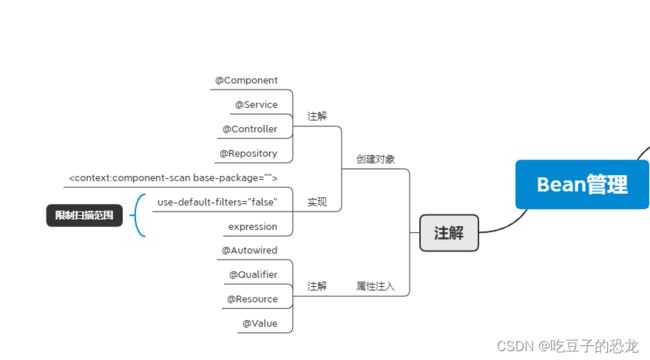Spring——Bean管理-注解方式进行属性注入
目录
思维导图
Spring进行bean管理有三种方式
Spring针对Bean管理中创建对象提供的注解有哪些?
用注解的方式是为什么?
如何实现注解开发?
创建对象
属性注入
完全注解开发
Spring系列文章
思维导图
Spring进行bean管理有三种方式
①、XML配置:在XML配置文件中,可以使用
②、注解:包括@Component、@Service、@Repository和@Controller等。Spring容器会扫描类路径下的所有注解,并根据注解的信息创建相应的Bean对象。
③、Java配置:可定义一个带有@Configuration注解的配置类,可以使用@Bean注解来指定Bean的创建方式和依赖关系。Spring容器会根据配置类中的定义,使用反射机制创建Bean对象。
这篇文章着重使用注解的方式来介绍bean的管理,那注解开发的好处是什么呢?
-
简化配置减少 XML 配置文件的数量和复杂度,提高配置的可读性和维护性。注解可以直接应用在代码中更加便捷
-
提高开发效率:减少样板代码的编写,比于XML 配置方式,注解更加简洁和直观,可以更快地完成开发任务
-
易于理解和维护:注解是直接应用在代码中的,通过注解,可以清晰地看到代码中的依赖关系和配置信息
Spring针对Bean管理中创建对象提供的注解有哪些?
@Component:普通
@Service:业务逻辑层
@Controller:controller层
@Repository:dao层
用注解的方式是为什么?
简化xml方式开发,只需要注解就可以完成在配置文件中的配置
如何实现注解开发?
创建对象
组件扫描
package com.atguigu.spring5.ComponentScan;
import org.springframework.stereotype.Component;
//value可以不写,如果不写默认是类名的首字母小写
@Component(value = "user")
public class User {
public void add() {
System.out.println("aaaa");
}
}
package com.atguigu.spring5.ComponentScan;
import org.springframework.context.ApplicationContext;
import org.springframework.context.support.ClassPathXmlApplicationContext;
public class Main {
public static void main(String[] args) {
ApplicationContext content= new ClassPathXmlApplicationContext("beans.xml");
User user = content.getBean("user", User.class);
user.add();
}
}
属性注入
@Autowired:根据类型注入,用于自动装配依赖对象。通过该注解,Spring会自动在容器中查找匹配的Bean,并将其注入到被注解的属性中。
@Qualifier:根据名称进行注入,当存在多个符合条件的Bean时,可以与@Autowired一起使用,用于指定具体要注入的Bean的名称。
@Value:可以根据类型或名称注入,用于注入简单类型的属性值,可以直接将配置文件中的值注入到属性中。
@Resource:与@Autowired类似,也用于自动装配依赖对象,但是它更加灵活,可以通过name属性指定具体要注入的Bean的名称
javax:java扩展包
完全注解开发
Configuration:作为配置类,替代xml配置文件
package com.atguigu.spring5.SpringConfiguration;
import org.springframework.context.annotation.ComponentScan;
import org.springframework.context.annotation.Configuration;
import org.springframework.stereotype.Component;
import org.springframework.stereotype.Controller;
@Configuration
@ComponentScan(basePackages = {"com.atguigu.spring5"})
public class SpringConfigure {
}
package com.atguigu.spring5.ScopeTest;
import org.springframework.stereotype.Component;
@Component
public class Book {
private String bname;
private String bauthor;
public void setBname(String bname) {
this.bname = bname;
}
public void setBauthor(String bauthor) {
this.bauthor = bauthor;
}
public static void main(String[] args) {
Book book = new Book();
book.setBname("abc");
}
public void testDemo() {
System.out.println(bname + "---" + "aaa");
}
}
package com.atguigu.spring5.SpringConfiguration;
import com.atguigu.spring5.ScopeTest.Book;
import org.springframework.context.ApplicationContext;
import org.springframework.context.annotation.AnnotationConfigApplicationContext;
import org.springframework.context.support.ClassPathXmlApplicationContext;
public class Main {
public static void main(String[] args) {
// 加载配置类
ApplicationContext context = new AnnotationConfigApplicationContext(SpringConfigure.class);
// 创建实例
Book book = context.getBean("book", Book.class);
// 调用方法
book.testDemo();
}
}输出结果:
Spring系列文章:
Spring——是什么?作用?内容?用到的设计模式?
Spring——Bean管理-xml方式进行属性注入
Spring——Bean管理-注解方式进行属性注入
Spring——什么是IOC?
Spring——AOP是什么?如何使用?
Spring——什么是事务?传播行为?事务隔离级别有哪些?
Spring——整合junit4、junit5使用方法



